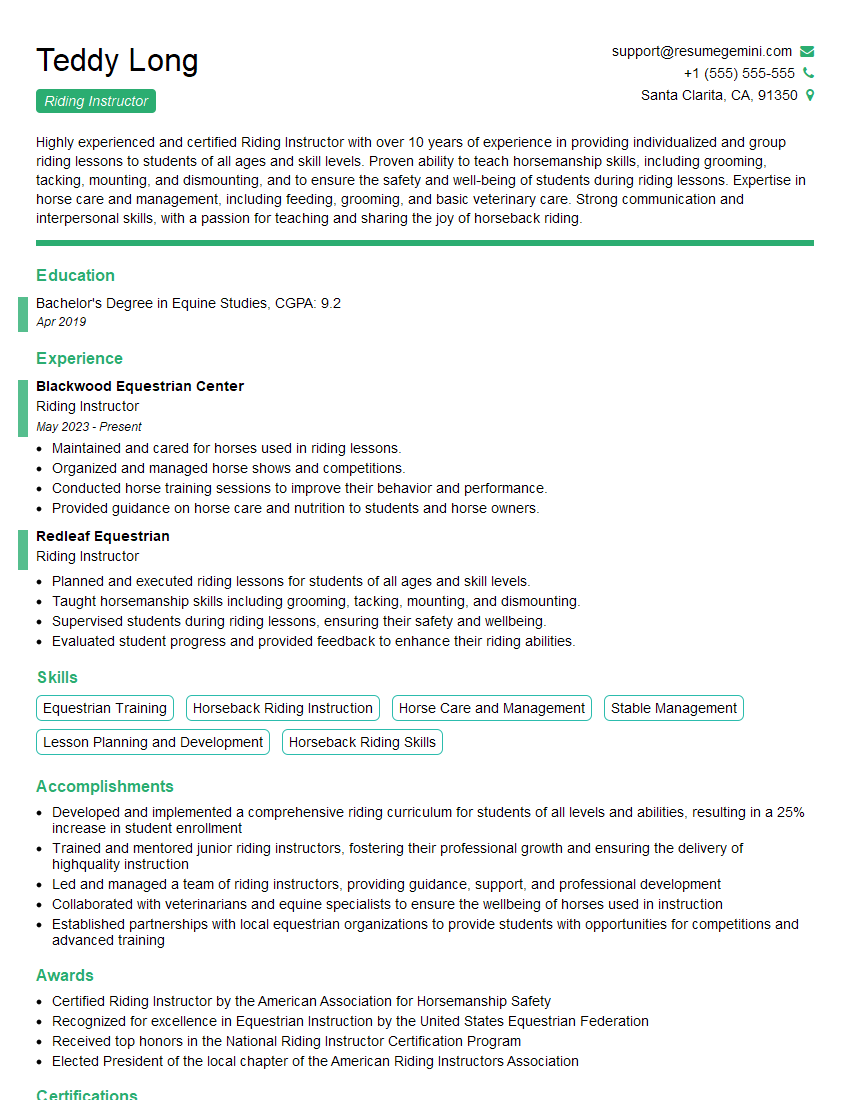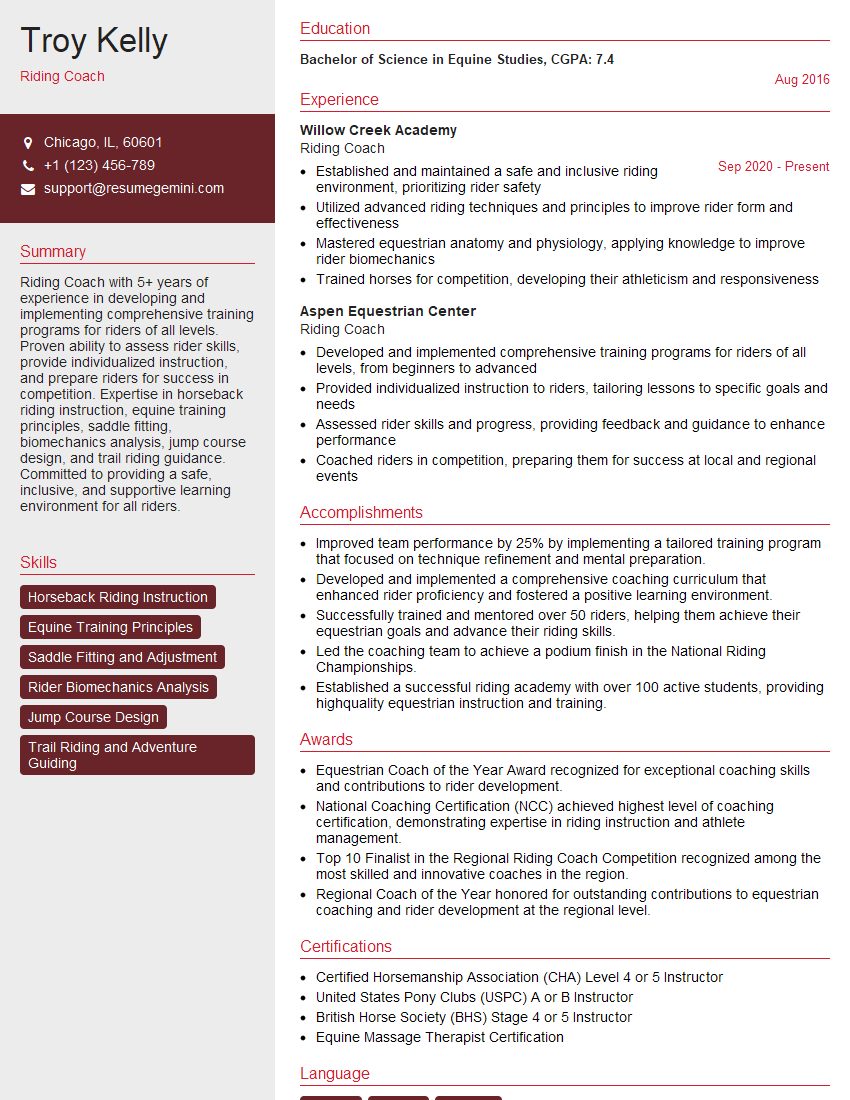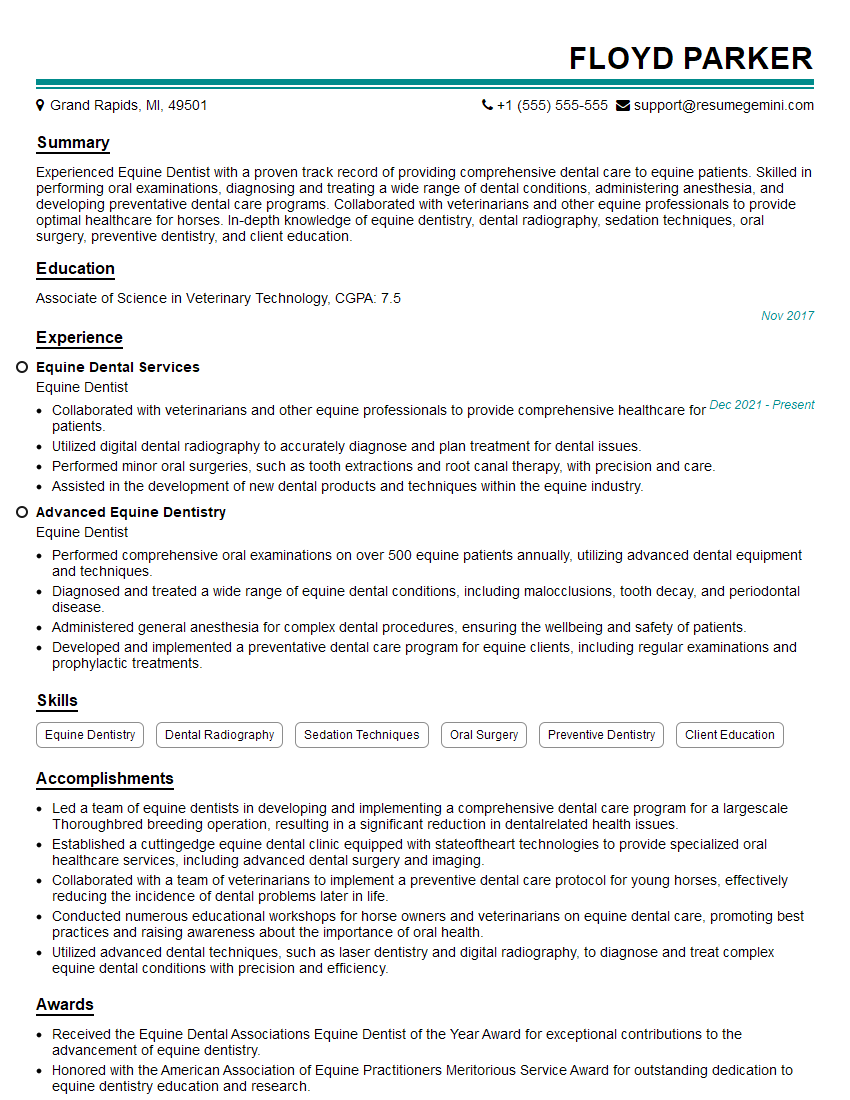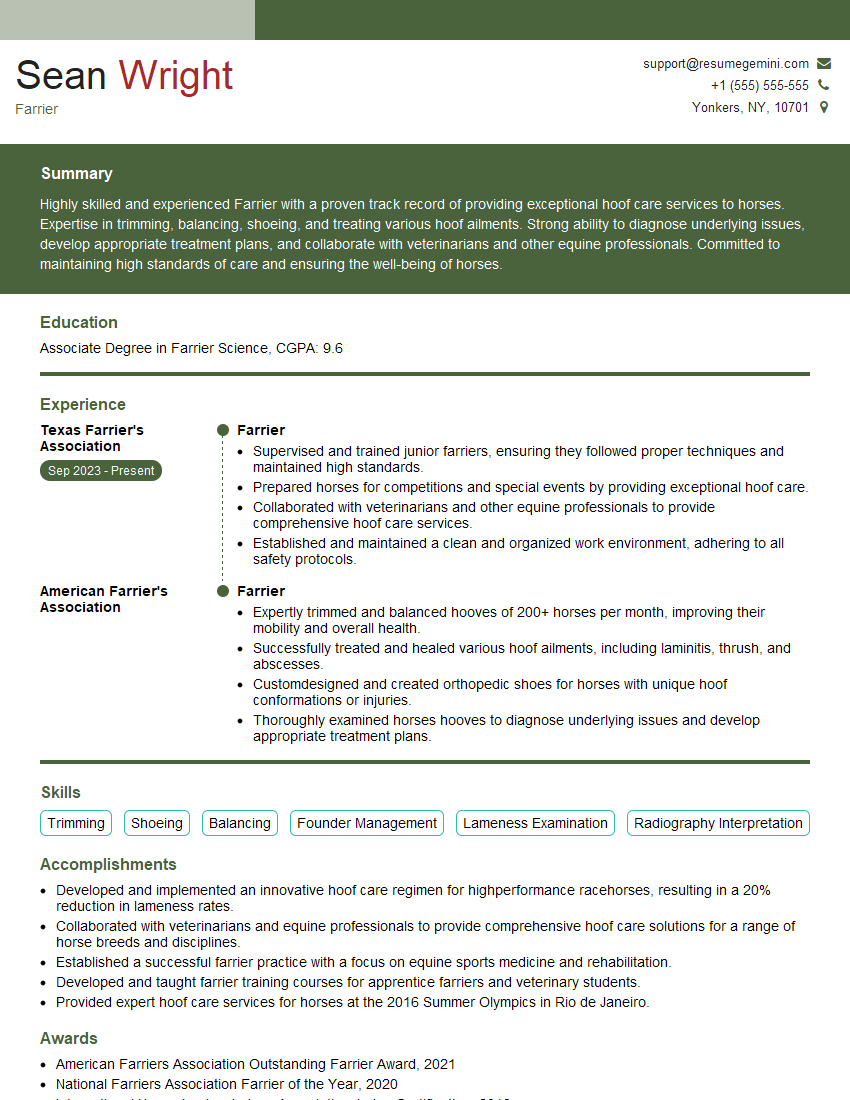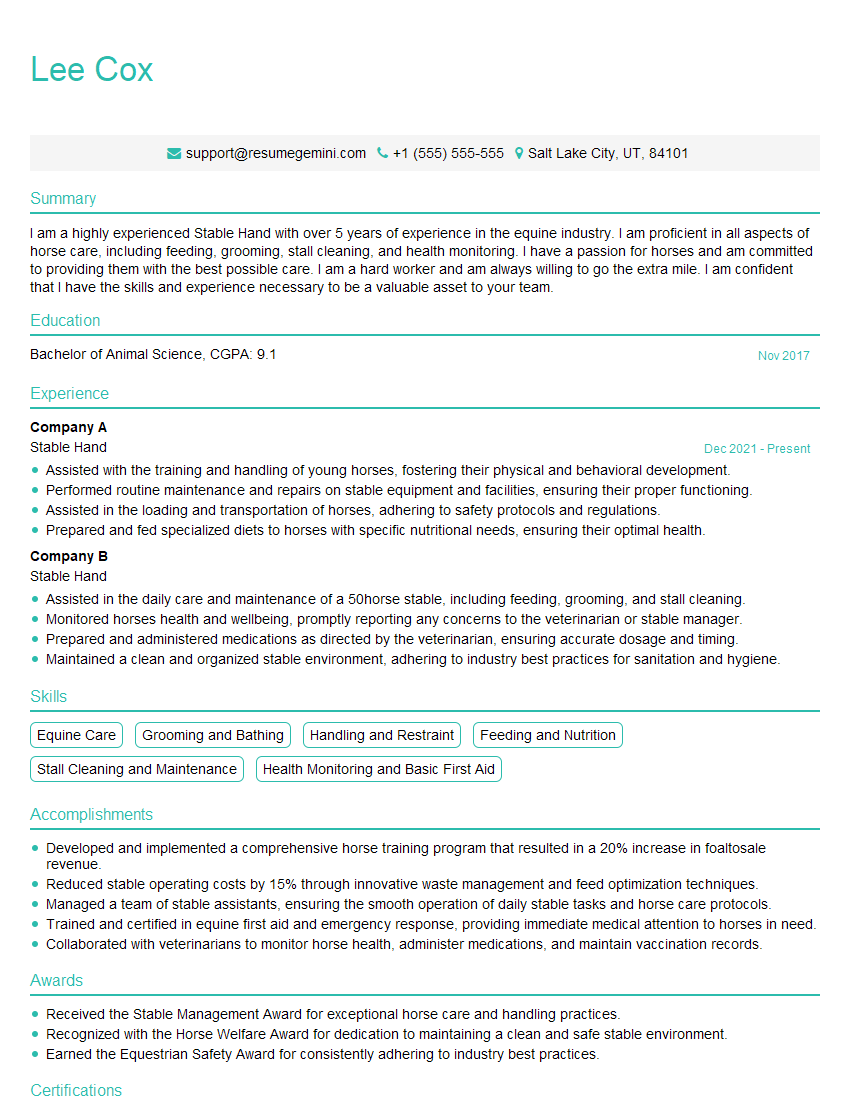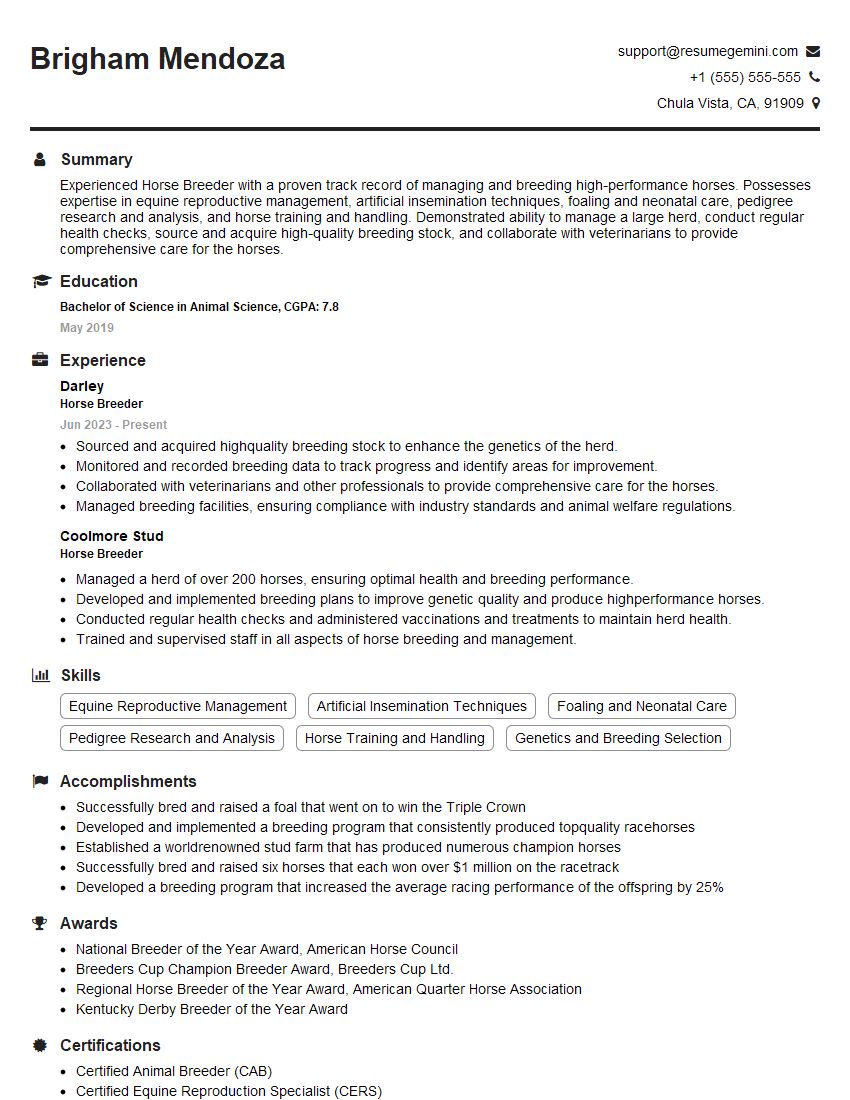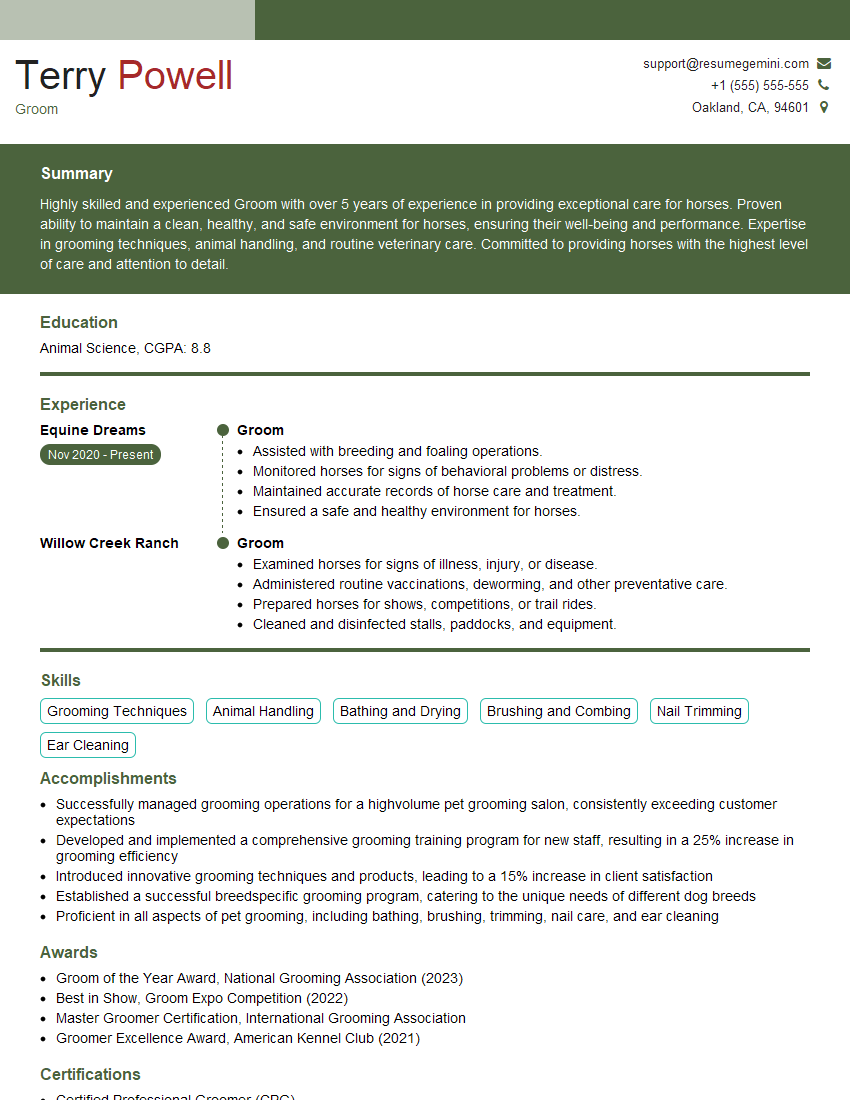Preparation is the key to success in any interview. In this post, we’ll explore crucial Horse Riding interview questions and equip you with strategies to craft impactful answers. Whether you’re a beginner or a pro, these tips will elevate your preparation.
Questions Asked in Horse Riding Interview
Q 1. Describe the different types of horse gaits.
Horses possess several distinct gaits, or ways of moving. These range from slow and deliberate to fast and powerful. The most basic are the walk, trot, and canter/lope. Let’s break them down:
- Walk: A four-beat gait, meaning each foot hits the ground separately. It’s the slowest gait and is used for relaxing rides and transitions. Think of it like a smooth, four-step process.
- Trot: A two-beat gait, with pairs of legs moving diagonally. It’s faster than a walk, creating a rhythmic bouncing motion. Imagine it like a bouncing ball, landing twice per cycle.
- Canter/Lope: A three-beat gait. It’s a more collected and controlled gait than a gallop. It involves a period of suspension as all four feet are off the ground. Think of it as a flowing, three-step rhythm.
- Gallop: A four-beat gait, significantly faster than the canter, with a period of suspension where all four feet leave the ground. This gait is used for speed and is quite strenuous for the horse.
- Pace: A two-beat gait where legs on the same side move together. This gait is more common in some breeds than others. Think of it as a lateral rocking motion.
Understanding these gaits is crucial for riders of all levels, allowing for better communication and control with the horse.
Q 2. Explain the importance of proper saddle fitting.
Proper saddle fitting is paramount for both the horse’s comfort and the rider’s safety and comfort. An ill-fitting saddle can cause significant pain and discomfort to the horse, leading to lameness, muscle soreness, and behavioral problems. For the rider, a poorly fitted saddle can lead to discomfort, instability, and even injury.
A well-fitted saddle should:
- Lie flat on the horse’s back: There shouldn’t be any pinching or bunching of the saddle pads.
- Allow for free movement of the horse’s shoulders: The saddle shouldn’t restrict the horse’s natural movement.
- Be appropriately sized for the horse: The saddle’s gullet width (the space between the pommel and cantle) must match the width of the horse’s back. Too narrow and it will pinch; too wide and it will slip.
- Be correctly positioned: It should sit evenly on the horse’s back, with the pommel just behind the withers.
Regular saddle checks by a qualified saddler are essential. Changes in the horse’s body condition can alter the fit of the saddle over time.
Q 3. How do you identify lameness in a horse?
Identifying lameness requires a keen eye and observation. Lameness is an abnormality in a horse’s gait or stance. It often indicates pain or discomfort. Look for these signs:
- Shortened stride: On the affected leg, the stride length is noticeably shorter.
- Head bobbing: The head drops when the lame leg hits the ground, as the horse tries to reduce weight on that leg.
- Swinging or favoring a leg: The horse may avoid placing weight on the affected leg.
- Heat or swelling: Feel for heat or swelling in the affected leg or hoof.
- Changes in behavior: The horse might be reluctant to move or appear stiff.
It’s critical to consult a veterinarian for a thorough examination if lameness is suspected. Various conditions can cause lameness, ranging from minor injuries to serious illnesses. A vet will determine the cause and recommend the appropriate treatment.
Q 4. What are the signs of colic in a horse?
Colic is a general term for abdominal pain in horses. It’s a serious condition that can be life-threatening. Recognizing the signs is crucial for prompt veterinary attention.
Signs of colic can vary in severity:
- Restlessness: The horse may paw the ground, roll, or repeatedly lie down and stand up.
- Flank-watching: The horse repeatedly looks toward its flanks.
- Sweating: Excessive sweating, even without exercise.
- Increased heart rate and respiratory rate: A faster-than-normal heart rate and breathing rate.
- Loss of appetite: Refusal to eat or drink.
- Rolling: Excessive or violent rolling.
If you suspect colic, contact a veterinarian immediately. Early intervention is critical. The cause of colic can range from simple gas to intestinal obstructions, and treatment varies depending on the underlying cause.
Q 5. Describe the different types of bridles and their uses.
Bridles are essential pieces of equipment used to control a horse. Different types serve specific purposes:
- Snaffle Bridle: The simplest type, utilizing a single jointed or straight snaffle bit. It’s suitable for young horses and basic riding. A direct rein action encourages a soft feel.
- Double Bridle: Consisting of two bits—a snaffle and a curb bit—it offers more control and leverage. Used for more advanced riding disciplines like dressage, where precise movements are needed. The curb bit adds more ‘power’.
- Hackamore Bridle: This bridle uses a noseband and a rein system that acts on the nose and poll rather than the mouth. Useful for horses sensitive in the mouth or those being started under saddle. This system prevents excessive pressure on the mouth.
- Sidepull Bridle: A specialized bridle that uses two reins which attach to rings either on the noseband or the cheekpieces. It’s often used for horses that are easily sensitive in their mouths.
The choice of bridle depends on the horse’s temperament, training level, and the rider’s skill and riding discipline. Correct bridle fitting is vital for horse comfort and effective communication.
Q 6. Explain the principles of horse training using classical dressage methods.
Classical dressage training focuses on developing the horse’s suppleness, balance, and obedience through precise movements and a system of progressive training. The core principles revolve around:
- Rhythm: Maintaining consistent and regular gaits is fundamental. Every movement starts and ends with rhythm.
- Suppleness: Developing the horse’s flexibility and looseness through lateral and longitudinal flexion exercises.
- Contact: Maintaining a steady and consistent connection with the reins, creating a gentle forward energy.
- Straightness: Ensuring the horse’s body is aligned correctly, avoiding crookedness or twisting. This affects all aspects of a horse’s movement.
- Impulsion: Developing the horse’s willingness and ability to move forward energetically yet under control. This is the ‘motor’ of the training.
Classical dressage is a gradual process. It emphasizes clear communication, patience, and consistency. Riders use aids such as leg pressure, rein contact, and seat to guide the horse. It focuses on developing a harmonious partnership between horse and rider.
Q 7. How do you handle a spooked horse?
Handling a spooked horse requires calm and assertive action. A spooked horse is reacting to a perceived threat, and your response will influence its reaction.
Steps to handle a spooked horse:
- Stay calm: Your own fear can be transmitted to the horse, exacerbating the situation. Speak in a soothing voice.
- Assess the situation: Identify the cause of the spook if possible. This will help you determine what action to take.
- Give the horse space: Don’t crowd the horse, but stay close enough to offer guidance and support.
- Use soft, reassuring voice commands: Give clear, gentle verbal cues, like ‘whoa’ or ‘easy’.
- Gentle pressure: If you’re mounted, use subtle rein and leg cues to guide the horse back to composure.
- Remove the stimulus: If safe to do so, remove the spook-causing object or redirect the horse’s attention away from it.
- Never panic: Remain calm and take control of the situation. Your confident reaction will help reassure the horse.
Experience and understanding of equine behavior are crucial in these situations. If the spook is severe or you’re unable to handle it safely, seek assistance from a more experienced rider or a professional.
Q 8. What are the common causes of respiratory problems in horses?
Respiratory problems in horses are a significant concern, impacting their performance and overall well-being. These issues can stem from various sources, broadly categorized as infectious, allergic, or environmental.
Infectious causes: These include viral infections like equine influenza or herpesvirus, bacterial infections like pneumonia (often secondary to other conditions), and fungal infections. Imagine a human catching a cold – similar principles apply, although the specific pathogens differ.
Allergic causes: Many horses suffer from allergies to dust, mold spores, pollen, and certain feedstuffs. These allergies can manifest as recurrent airway obstruction (RAO), similar to human asthma, causing wheezing, coughing, and difficulty breathing. Think of how some people react to seasonal changes.
Environmental causes: Poor air quality in stables, such as high dust levels from poorly managed bedding, can irritate the airways. Ammonia fumes from urine also contribute to respiratory issues. Just as humans need clean air, horses require a well-ventilated environment.
Diagnosis typically involves a thorough clinical examination, including auscultation (listening to the lungs), and potentially blood tests, radiographs (X-rays), and bronchoalveolar lavage (BAL) to identify the underlying cause and guide appropriate treatment, which might involve medications, environmental modifications, and management of underlying conditions.
Q 9. Describe the proper procedure for shoeing a horse.
Shoeing a horse is a skilled procedure requiring expertise and precision. It’s crucial to ensure the horse’s comfort and hoof health. The process involves several steps:
Preparation: The horse’s hooves are cleaned thoroughly, removing dirt and debris. The farrier assesses the hoof’s condition and evaluates the wear pattern.
Trimming: Excess hoof wall is trimmed using specialized tools, shaping the hoof to promote proper weight distribution and balance. This is like giving a human a manicure, but on a much larger scale.
Fitting the shoe: The farrier selects the appropriate shoe size and shape, considering the horse’s conformation, discipline, and workload. The shoe is carefully fitted to the trimmed hoof.
Nail application: The shoe is secured to the hoof using special nails, driven carefully to avoid damaging the sensitive inner structures of the hoof. Each nail needs precise placement.
Finishing: Once the shoe is securely attached, the nails are clinched (bent over) to prevent them from working loose. Any sharp edges are filed down to ensure the shoe fits smoothly and comfortably.
The entire process demands a deep understanding of equine anatomy, hoof physiology, and the use of specialized tools. A well-shod horse enjoys greater comfort, improved gait, and reduced risk of hoof injuries. Poor shoeing can lead to lameness, hoof deformities, and other problems.
Q 10. How do you manage a horse with stable vices?
Stable vices, such as cribbing, weaving, and wood chewing, are often signs of underlying stress or boredom in horses. Management involves addressing both the behavioral symptoms and the root causes.
Environmental enrichment: Providing ample opportunities for social interaction (with compatible herdmates), regular exercise, and access to forage can significantly reduce stress. Imagine keeping a human occupied and happy to avoid boredom-induced habits.
Behavioral modification: This might involve techniques like desensitization and counter-conditioning to discourage the vice. For example, a cribbing strap can help manage cribbing, but it’s not a cure; it must be combined with addressing the underlying causes.
Dietary changes: Some vices are linked to dietary deficiencies or imbalances. Ensuring a well-balanced diet with adequate fiber and minimal grain can help. This is like providing a balanced meal for a human to prevent unhealthy eating habits.
Veterinary consultation: Underlying medical conditions can sometimes contribute to stable vices. A veterinary examination is crucial to rule out any physical issues. This is critical to address any underlying health conditions impacting behavior.
Managing stable vices requires a multi-faceted approach, combining environmental changes, behavioral modification, and potential dietary adjustments. Success often hinges on identifying and resolving the underlying reasons for the behavior.
Q 11. What are the different types of horse feed and their nutritional value?
Equine nutrition is complex, with various feed types offering different nutritional profiles. The ideal diet depends on the horse’s age, workload, and physiological state.
Hay: The cornerstone of most equine diets. Provides fiber, essential for digestive health and satiety. Different types of hay (e.g., grass hay, alfalfa) have varying nutritional compositions.
Grain: Concentrates providing readily available energy, often used for performance horses or those with high energy demands. Oats, corn, and barley are common ingredients, but the proportions must be carefully controlled to avoid metabolic issues. Think of it as a high-energy human snack.
Supplements: Used to address specific nutritional deficiencies or support specific physiological functions. Vitamins, minerals, and electrolytes are commonly supplemented.
Commercial feeds: Pre-mixed feeds that combine grains, hay, and supplements in specific ratios designed for particular needs (e.g., growing horses, senior horses, performance horses).
Proper nutrition is paramount for maintaining a horse’s health, soundness, and performance. An unbalanced diet can lead to various problems, including weight loss, obesity, metabolic disorders, and poor performance.
Q 12. Explain the importance of parasite control in horses.
Parasite control is crucial for maintaining the health and well-being of horses. Internal parasites (e.g., roundworms, tapeworms) and external parasites (e.g., lice, mites, flies) can cause significant health problems, impacting performance and even leading to death.
Regular fecal egg counts: These tests assess the level of internal parasite infestation, guiding appropriate deworming strategies. It’s like taking a human blood test to monitor health.
Targeted deworming: Rather than routine blanket deworming (which contributes to anthelmintic resistance), a targeted approach based on fecal egg counts and the horse’s individual risk factors is more effective and sustainable.
Pasture management: Rotation of pastures and removal of manure can help reduce parasite burdens in the environment. It is similar to proper sanitation to prevent disease spread among humans.
Fly control: Regular use of fly sprays, fly masks, and stable management practices (e.g., manure removal) can minimize fly infestation.
Implementing a comprehensive parasite control program is essential for maintaining a healthy herd, and helps prevent parasite-related illnesses and improves the overall welfare of the horses.
Q 13. Describe your experience with different riding disciplines.
My experience encompasses a wide range of equestrian disciplines. I’ve competed in and trained horses in dressage, where the focus is on precision and elegance of movement; eventing, which combines dressage, cross-country, and show jumping; and western riding, encompassing disciplines like reining and cutting. I’ve also spent considerable time in therapeutic riding, using horses to help individuals with physical or cognitive challenges.
Each discipline demands a unique set of skills and knowledge. For example, dressage requires meticulous attention to detail and a deep understanding of equine biomechanics. Eventing tests the horse’s and rider’s athleticism and stamina. Western riding necessitates a different approach, focusing on partnership and communication.
This broad experience has provided me with a holistic understanding of horse training, riding techniques, and the specific demands of different equestrian pursuits.
Q 14. How do you assess a horse’s temperament and suitability for a specific rider?
Assessing a horse’s temperament and suitability for a specific rider is crucial for ensuring both the horse’s and rider’s safety and enjoyment. This requires a multi-faceted approach:
Observation: Observing the horse’s behavior in various situations – in the stable, in the paddock, during handling, and under saddle – provides valuable insights into its temperament. Is the horse calm and easygoing, or more excitable and reactive?
Interaction: Direct interaction with the horse allows assessment of its responsiveness to handling, its willingness to cooperate, and its overall demeanor. How does the horse react to being touched, groomed, and saddled? Does it have a playful, curious attitude or a more serious, reserved one?
Rider assessment: Understanding the rider’s experience, skill level, and riding goals is essential. A beginner might require a calmer, more forgiving horse, while an experienced rider might be comfortable with a more challenging mount.
Matching personalities: A successful partnership relies on matching the horse’s temperament to the rider’s personality and riding style. A sensitive, quiet rider may not be well-suited to a highly spirited horse. Similarly, an inexperienced rider may struggle with a more difficult horse.
Ultimately, a thorough assessment of both the horse and the rider ensures a safe and harmonious partnership, promoting a positive and enjoyable experience for both.
Q 15. What safety precautions do you take when handling horses?
Safety around horses is paramount. It’s about anticipating their behavior and minimizing risk. My approach is built on a foundation of respect, awareness, and proactive measures.
- Approaching a horse: I always approach from the horse’s left side (near side), speaking softly and calmly to avoid startling it. I never approach from the rear as they can kick unexpectedly.
- Handling the head: When handling the head, I use a gentle but firm touch, avoiding sudden movements. I never put my face close to the horse’s head because of the risk of being bitten.
- Body language awareness: I constantly observe the horse’s body language—ears, tail, and overall posture—for signs of stress or agitation. A pinned-back ear or swishing tail is a clear warning signal to back off and reassess.
- Proper equipment: I always use appropriate equipment like halters and lead ropes in good condition, ensuring a secure fit. I regularly check for any wear and tear.
- Never assume calm behavior: Even the calmest horse can be unpredictable, so I maintain a safe distance and avoid actions that might provoke it. I never assume predictability.
For example, once I was working with a seemingly docile mare when a loud noise startled her. Had I not been maintaining a safe distance, I might have been injured. This incident underscored the importance of constant vigilance.
Career Expert Tips:
- Ace those interviews! Prepare effectively by reviewing the Top 50 Most Common Interview Questions on ResumeGemini.
- Navigate your job search with confidence! Explore a wide range of Career Tips on ResumeGemini. Learn about common challenges and recommendations to overcome them.
- Craft the perfect resume! Master the Art of Resume Writing with ResumeGemini’s guide. Showcase your unique qualifications and achievements effectively.
- Don’t miss out on holiday savings! Build your dream resume with ResumeGemini’s ATS optimized templates.
Q 16. How do you handle a horse that is resistant to training?
Dealing with a resistant horse requires patience, understanding, and a systematic approach. It’s crucial to identify the root cause of the resistance—is it fear, pain, poor training, or a combination?
- Identify the problem: Thoroughly assess the horse’s behavior. Is it resisting a specific command, exhibiting general unwillingness to work, or showing signs of pain or discomfort? A vet check is often the first step.
- Positive reinforcement: I primarily focus on positive reinforcement techniques, rewarding even small successes with praise, treats, and releasing pressure when the horse complies. I use classical and operant conditioning methods.
- Desensitization: If the resistance stems from fear, I slowly desensitize the horse to the stimulus causing the problem. For example, if a horse is afraid of a tarp, I introduce it gradually, allowing the horse to investigate at its own pace.
- Professional help: Sometimes, professional help is needed. A certified equine behaviorist can provide expert guidance and create a tailored training program.
- Consistency: The key to overcoming resistance is consistency. The horse needs clear, consistent cues and rewards to understand what’s expected.
I once worked with a young stallion who resisted mounting. Through patience, positive reinforcement, and gradually introducing him to the saddle and mounting process, he eventually became cooperative and even enthusiastic about riding.
Q 17. Describe your experience with horse transportation and handling.
My experience with horse transportation and handling encompasses both long-distance travel and short trips. Safety and the horse’s well-being are my top priorities.
- Secure transport: I ensure the horse is properly secured in a suitable trailer with adequate ventilation and padding. I frequently check straps and the horse’s condition during transit.
- Travel preparation: Before transport, I ensure the horse is well-hydrated, rested, and has eaten lightly. I minimize stress by avoiding sudden movements or loud noises.
- Loading and unloading: I use calm, reassuring techniques when loading and unloading the horse, ensuring a smooth and safe process. Patience is key here.
- Post-travel care: After arrival, I monitor the horse closely, providing water, rest, and checking for any signs of injury or stress. I check for any injuries from rubbing against the trailer walls.
- Legal aspects: I am familiar with all relevant regulations and documentation needed for transporting horses across state lines or internationally.
I remember one instance where I transported a valuable stallion across the country. Meticulous planning and attention to detail ensured a stress-free journey for the horse and a safe arrival at its destination. Proper preparation and attention to detail are key.
Q 18. What is your experience with breeding and foaling?
My experience with breeding and foaling involves all aspects, from selecting breeding pairs to managing the mare during pregnancy and assisting with the foaling process.
- Breeding selection: I consider factors such as pedigree, conformation, temperament, and health when selecting breeding pairs to enhance the foal’s qualities.
- Pregnancy monitoring: Regular monitoring throughout pregnancy is critical, including ultrasounds and veterinary checkups to ensure a healthy gestation and to detect any potential complications.
- Foaling preparation: I prepare a clean, spacious foaling stall with bedding and all necessary supplies before the expected foaling date.
- Foaling assistance: In case of complications, I know how to provide assistance. This often involves veterinary intervention.
- Post-foaling care: Once the foal is born, I monitor both mare and foal, ensuring the foal nurses and the mare’s milk production is adequate. I also ensure proper hygiene to prevent infections.
One memorable experience involved assisting with the foaling of a mare who experienced some difficulties during labor. Swift intervention, communication with the vet, and calm handling ensured a positive outcome for both mare and foal.
Q 19. How do you manage injuries in horses?
Managing horse injuries involves prompt assessment, appropriate first aid, and veterinary care. Early intervention is key to a positive outcome.
- Initial assessment: I assess the extent and nature of the injury. This includes observing the horse’s behavior and checking for signs of pain or lameness.
- First aid: I provide basic first aid, such as cleaning wounds, applying antiseptic, and bandaging, while ensuring the horse’s safety and comfort.
- Veterinary care: I immediately contact a veterinarian for more serious injuries or if the injury requires advanced treatment, such as suturing or splinting.
- Ongoing care: Post-injury care involves rest, medication, and physiotherapy as recommended by the veterinarian.
- Preventative measures: Regular hoof care, proper turnout management, and providing adequate nutrition can significantly reduce the risk of injury. I implement preventative strategies whenever possible.
I remember treating a horse with a severe cut to its leg. Immediate cleaning, appropriate bandaging, and veterinary care resulted in a speedy and near-complete recovery. This highlighted the critical importance of rapid response and expert veterinary care.
Q 20. Describe your knowledge of equine anatomy and physiology.
My knowledge of equine anatomy and physiology is comprehensive. This understanding is crucial for assessing a horse’s health, diagnosing problems, and tailoring training and care appropriately.
- Musculoskeletal system: I understand the intricate structure of a horse’s bones, muscles, tendons, and ligaments, which helps me understand locomotion and identify potential lameness issues.
- Digestive system: I’m aware of the unique digestive system of horses, particularly their reliance on consistent fiber intake. This helps me understand their nutritional needs and identify potential digestive problems. I am adept at identifying symptoms of colic.
- Respiratory system: I can recognize signs of respiratory distress, such as increased respiratory rate or abnormal sounds. This knowledge helps in quickly addressing potential problems like heaves.
- Cardiovascular system: I can understand the function of a horse’s heart and circulatory system, including signs of heart conditions.
- Nervous system: I understand the nervous system and how it influences behavior. This knowledge is important for recognizing neurological issues.
This detailed understanding allows me to recognize subtle changes in behavior and performance that might indicate an underlying health issue. It is also key to choosing suitable riding and training techniques.
Q 21. What are your experience with different types of riding tack?
My experience encompasses a wide variety of riding tack, from basic equipment to specialized gear for different disciplines.
- English tack: I’m proficient in the use and fitting of English saddles (dressage, jumping, general purpose), bridles (various bit types), and other related equipment. I am familiar with proper saddle fitting to prevent discomfort and injury.
- Western tack: I’m experienced with Western saddles, bridles, and other accoutrements specific to Western riding styles. I understand the differences in saddle styles and their impact on the rider and horse.
- Specialized tack: I have experience with specialized tack, such as therapeutic saddles, specialized bits, and other equipment designed for specific training or rehabilitative purposes.
- Tack maintenance: I’m knowledgeable about proper tack cleaning, maintenance, and storage to ensure the longevity and safety of the equipment.
- Tack fitting: Proper tack fitting is crucial for both rider comfort and the horse’s well-being. I can ensure a safe and comfortable fit for both the horse and rider.
For example, I’ve worked with horses that required therapeutic saddles due to back problems. The correct saddle significantly improved the horse’s comfort and performance, showcasing the importance of choosing the right equipment.
Q 22. How would you handle a situation where a horse is injured during a ride?
Handling a horse injury during a ride requires immediate, calm action. Prioritizing the horse’s safety and well-being is paramount. My first step would be to assess the situation. Is the injury life-threatening? Is the horse in immediate danger (e.g., from traffic, falling)? If so, I would move the horse to a safe location, if possible, ensuring my own safety in the process.
For minor injuries like a small cut or scrape, I would clean the wound with appropriate antiseptic and apply a bandage. More serious injuries like a broken leg or deep wound require immediate veterinary attention. I would contact emergency veterinary services immediately and remain with the horse, providing comfort and reassurance until help arrives. I’d also document the incident, noting the time, location, and nature of the injury. This information is crucial for the veterinarian and any subsequent insurance claims. For example, I once had a horse stumble and cut its leg on a fence post during a trail ride. I quickly assessed the wound, cleaned it with a portable antiseptic kit I always carry, applied a pressure bandage, and called the vet, who arrived and stitched the wound. The horse recovered fully.
Q 23. Explain your knowledge of equine first aid.
Equine first aid is a critical skill for any horse professional. My knowledge encompasses a wide range of techniques, from treating minor wounds and lacerations to handling more serious emergencies. This includes wound cleaning and bandaging techniques, using appropriate antiseptic solutions, recognizing and responding to signs of colic (severe abdominal pain), recognizing and treating shock, applying pressure bandages to control bleeding, and knowing when to call for veterinary assistance. It’s crucial to be familiar with the horse’s anatomy to properly assess and address injuries.
For example, I know that a horse exhibiting signs of colic, such as pawing, rolling, and kicking at its abdomen, needs immediate veterinary care. Delay can be fatal. I also understand how to splint a fractured limb, though this should only be attempted with appropriate training and if veterinary help is delayed. I always carry a comprehensive first-aid kit for horses, including antiseptic solutions, bandages, wound dressings, and a thermometer.
Q 24. What is your experience with training young horses?
Training young horses requires patience, consistency, and a deep understanding of equine behavior. My approach focuses on building trust and establishing a strong foundation of respect. I start with groundwork, focusing on desensitization and basic handling techniques. This involves exposing the horse to different stimuli in a calm and controlled manner, gradually increasing the intensity. Then, I transition to saddle training, introducing the saddle and rider gradually. The focus is always on positive reinforcement, rewarding desired behaviors with praise and treats.
I believe in creating a safe and supportive learning environment for both the horse and the handler. I use positive reinforcement methods to encourage the horse to learn and progress at its own pace. For instance, with one young horse I spent weeks just building trust through groundwork before even attempting to put a saddle on. The result? A calm, well-trained horse.
Q 25. How do you ensure the safety and wellbeing of your horses?
Ensuring the safety and well-being of my horses is my top priority. This involves several key aspects. Firstly, providing a clean, safe, and spacious living environment. This means regular stall cleaning, ensuring adequate ventilation, and providing ample space for movement. I also prioritize proper nutrition, providing balanced diets tailored to the individual needs of each horse, and access to fresh water at all times. Regular veterinary checkups are crucial for early detection and prevention of health problems.
Beyond the basics, I ensure the horses have access to appropriate exercise and enrichment activities. This might include turnout in a paddock, regular riding sessions, or interactive playtime. I carefully monitor their behaviour for any signs of illness or injury. I’m diligent about foot care and routine dental checks as well. A happy horse is a healthy horse, and I meticulously attend to every aspect of their well-being.
Q 26. How do you communicate effectively with riders of varying skill levels?
Communicating effectively with riders of varying skill levels requires adaptability and clear, concise instruction. I tailor my communication style to match the individual’s experience and understanding. For beginners, I use simple, clear language and demonstrate techniques before asking them to perform them. I focus on building a strong foundation and providing ample positive feedback. With more experienced riders, I offer more advanced instruction and encourage them to refine their technique. I also actively listen to their feedback and concerns.
I use a variety of teaching methods, including demonstrations, verbal instructions, and written materials, adjusting the approach to each rider’s learning style. For example, if a rider struggles with balance, I will provide specific exercises to help improve their posture and core strength, while if a rider is more advanced and wishes to improve their jumping technique, I will provide specialized instruction and feedback.
Q 27. Describe your experience with managing a stable and its resources.
My experience in stable management encompasses all aspects of operation, from routine maintenance to financial management. I’m proficient in overseeing the daily care of horses, including feeding, grooming, mucking stalls, and monitoring health. I oversee staff scheduling, training, and task delegation. I maintain meticulous records of each horse’s health, diet, and training progress. Resource management includes budgeting, purchasing supplies, and maintaining the facilities. This also includes maintaining equipment and conducting regular safety inspections to minimize risk.
In a previous role, I successfully managed a stable with 20 horses, overseeing a team of five staff members. I developed and implemented a system for inventory control and supply ordering, reducing expenses by 15%. I also developed and implemented a preventative maintenance program for the stable facilities, extending the lifespan of our equipment.
Q 28. What is your approach to horse welfare and ethical riding practices?
My approach to horse welfare and ethical riding practices is holistic and centered on the well-being of the horse. This means respecting the horse’s physical and emotional needs. It involves using humane and positive training methods, avoiding harsh or coercive techniques. I believe in building trust and rapport with the horse through positive reinforcement and clear communication. Ethical riding involves understanding the horse’s limitations and adapting the riding style accordingly. I would never push a horse beyond its capabilities or engage in activities that could endanger its health or safety.
I advocate for responsible horse ownership, emphasizing the importance of proper nutrition, veterinary care, and appropriate exercise. I’m a strong proponent of continuing education on equine welfare and constantly strive to stay updated on best practices in equine care. For example, I regularly participate in workshops and conferences to enhance my knowledge and skills in this field.
Key Topics to Learn for Horse Riding Interview
- Horse Behavior and Psychology: Understanding equine body language, temperament, and common behavioral issues. Practical application includes recognizing signs of stress or discomfort in a horse and adjusting your approach accordingly.
- Riding Techniques and Disciplines: Mastering fundamental riding skills across various disciplines (e.g., dressage, jumping, western riding). Practical application involves demonstrating proficiency in chosen disciplines and adapting techniques based on the horse’s needs and the riding environment.
- Equine Health and Welfare: Knowledge of common equine health problems, basic first aid, and stable management practices. Practical application includes demonstrating responsible horse care, recognizing signs of illness or injury, and ensuring the horse’s well-being.
- Tack and Equipment: Familiarity with different types of tack, their proper use, and maintenance. Practical application includes correctly fitting and adjusting tack, identifying potential safety hazards, and ensuring the horse’s comfort.
- Safety Procedures and Risk Management: Understanding and implementing safety protocols in the stable and riding arena. Practical application involves demonstrating a commitment to safety for both the rider and the horse, and the ability to assess and mitigate risks.
- Training and Communication: Effective communication with horses through aids and clear, consistent training techniques. Practical application involves explaining your training philosophy and demonstrating the ability to build a positive relationship with a horse.
- Stable Management: Understanding daily stable routines, including feeding, grooming, and mucking stalls. Practical application involves demonstrating knowledge of best practices for maintaining a clean and safe stable environment.
Next Steps
Mastering horse riding is a valuable skill set that opens doors to diverse and rewarding career opportunities, from competitive riding to equestrian instruction and stable management. To maximize your job prospects, crafting an ATS-friendly resume is crucial. A well-structured resume that highlights your skills and experience effectively increases your chances of landing an interview. ResumeGemini is a trusted resource that can help you build a professional and impactful resume tailored to the specific requirements of your target roles. Examples of resumes tailored to the Horse Riding industry are available to help guide you.
Explore more articles
Users Rating of Our Blogs
Share Your Experience
We value your feedback! Please rate our content and share your thoughts (optional).
What Readers Say About Our Blog
Hello,
We found issues with your domain’s email setup that may be sending your messages to spam or blocking them completely. InboxShield Mini shows you how to fix it in minutes — no tech skills required.
Scan your domain now for details: https://inboxshield-mini.com/
— Adam @ InboxShield Mini
Reply STOP to unsubscribe
Hi, are you owner of interviewgemini.com? What if I told you I could help you find extra time in your schedule, reconnect with leads you didn’t even realize you missed, and bring in more “I want to work with you” conversations, without increasing your ad spend or hiring a full-time employee?
All with a flexible, budget-friendly service that could easily pay for itself. Sounds good?
Would it be nice to jump on a quick 10-minute call so I can show you exactly how we make this work?
Best,
Hapei
Marketing Director
Hey, I know you’re the owner of interviewgemini.com. I’ll be quick.
Fundraising for your business is tough and time-consuming. We make it easier by guaranteeing two private investor meetings each month, for six months. No demos, no pitch events – just direct introductions to active investors matched to your startup.
If youR17;re raising, this could help you build real momentum. Want me to send more info?
Hi, I represent an SEO company that specialises in getting you AI citations and higher rankings on Google. I’d like to offer you a 100% free SEO audit for your website. Would you be interested?
Hi, I represent an SEO company that specialises in getting you AI citations and higher rankings on Google. I’d like to offer you a 100% free SEO audit for your website. Would you be interested?
good
